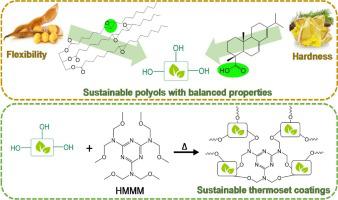当前位置:
X-MOL 学术
›
Prog. Org. Coat.
›
论文详情
Our official English website, www.x-mol.net, welcomes your
feedback! (Note: you will need to create a separate account there.)
Development of sustainable polyols with high bio-renewable content and their applications in thermoset coatings
Progress in Organic Coatings ( IF 6.5 ) Pub Date : 2020-10-01 , DOI: 10.1016/j.porgcoat.2020.105725 Forough Zareanshahraki , Jingjing Lu , Shiyin Yu , Ali Kiamanesh , Banafsheh Shabani , Vijay Mannari
Progress in Organic Coatings ( IF 6.5 ) Pub Date : 2020-10-01 , DOI: 10.1016/j.porgcoat.2020.105725 Forough Zareanshahraki , Jingjing Lu , Shiyin Yu , Ali Kiamanesh , Banafsheh Shabani , Vijay Mannari

|
Abstract In recent years, bio-renewable based materials have been increasingly explored as a promising replacement for petroleum-based ones used as building blocks for polymers. This trend is mainly driven by the increasing awareness and directives for the sustainable development of polymeric materials, including coatings. The lower carbon footprint compared to their petroleum counterparts and depleting known resources of petroleum makes bio-renewable materials very important for future development. However, it is very important to meticulously design polymers based on bio-renewable building blocks by leveraging their unique chemistry and functionality, to meet the demanding requirements of the final products at acceptable costs. In the present work, by combining unique features and functionalities of two low-cost commercial commodity bio-renewable based materials - Epoxidized soybean oil (ESO) and rosin – polymeric polyols with bio-renewable content > 78 % by weight have been successfully developed. A series of single-component melamine-formaldehyde (MF) cured thermoset coatings have been then formulated and evaluated. Some of the prepared coatings demonstrated excellent adhesion (5B), high MEK-Double-Rubs (100–200), high gloss @ 60° (>80), and promising flexibility and impact resistance properties (140−160 lb.in). The outcome of this study clearly demonstrates the suitability of these polyols as primary components of sustainable industrial coatings.
中文翻译:

具有高生物可再生含量的可持续多元醇的开发及其在热固性涂料中的应用
摘要 近年来,人们越来越多地探索生物可再生基材料,以替代石油基材料作为聚合物的基础材料。这一趋势主要是由于对聚合物材料(包括涂料)可持续发展的认识和指令不断提高。与石油同行相比,碳足迹较低,并且消耗了已知的石油资源,这使得生物可再生材料对未来的发展非常重要。然而,通过利用其独特的化学和功能来精心设计基于生物可再生构建块的聚合物,以可接受的成本满足最终产品的苛刻要求非常重要。在目前的工作中,通过结合两种低成本商业商品生物可再生材料的独特特性和功能 - 环氧化大豆油 (ESO) 和松香 - 生物可再生含量大于 78% 的聚合物多元醇已成功开发。然后制定并评估了一系列单组分三聚氰胺-甲醛 (MF) 固化热固性涂料。一些制备的涂层表现出优异的附着力 (5B)、高 MEK-Double-Rubs (100-200)、高光泽 @ 60° (>80) 以及有前途的柔韧性和抗冲击性能 (140-160 lb.in)。这项研究的结果清楚地证明了这些多元醇作为可持续工业涂料的主要成分的适用性。已成功开发了 78%(重量)。然后制定并评估了一系列单组分三聚氰胺-甲醛 (MF) 固化热固性涂料。一些制备的涂层表现出优异的附着力 (5B)、高 MEK-Double-Rubs (100-200)、高光泽 @ 60° (>80) 以及有前途的柔韧性和抗冲击性能 (140-160 lb.in)。这项研究的结果清楚地证明了这些多元醇作为可持续工业涂料的主要成分的适用性。已成功开发了 78%(重量)。然后制定并评估了一系列单组分三聚氰胺-甲醛 (MF) 固化热固性涂料。一些制备的涂层表现出优异的附着力 (5B)、高 MEK-Double-Rubs (100-200)、高光泽 @ 60° (>80) 以及有前途的柔韧性和抗冲击性能 (140-160 lb.in)。这项研究的结果清楚地证明了这些多元醇作为可持续工业涂料的主要成分的适用性。
更新日期:2020-10-01
中文翻译:

具有高生物可再生含量的可持续多元醇的开发及其在热固性涂料中的应用
摘要 近年来,人们越来越多地探索生物可再生基材料,以替代石油基材料作为聚合物的基础材料。这一趋势主要是由于对聚合物材料(包括涂料)可持续发展的认识和指令不断提高。与石油同行相比,碳足迹较低,并且消耗了已知的石油资源,这使得生物可再生材料对未来的发展非常重要。然而,通过利用其独特的化学和功能来精心设计基于生物可再生构建块的聚合物,以可接受的成本满足最终产品的苛刻要求非常重要。在目前的工作中,通过结合两种低成本商业商品生物可再生材料的独特特性和功能 - 环氧化大豆油 (ESO) 和松香 - 生物可再生含量大于 78% 的聚合物多元醇已成功开发。然后制定并评估了一系列单组分三聚氰胺-甲醛 (MF) 固化热固性涂料。一些制备的涂层表现出优异的附着力 (5B)、高 MEK-Double-Rubs (100-200)、高光泽 @ 60° (>80) 以及有前途的柔韧性和抗冲击性能 (140-160 lb.in)。这项研究的结果清楚地证明了这些多元醇作为可持续工业涂料的主要成分的适用性。已成功开发了 78%(重量)。然后制定并评估了一系列单组分三聚氰胺-甲醛 (MF) 固化热固性涂料。一些制备的涂层表现出优异的附着力 (5B)、高 MEK-Double-Rubs (100-200)、高光泽 @ 60° (>80) 以及有前途的柔韧性和抗冲击性能 (140-160 lb.in)。这项研究的结果清楚地证明了这些多元醇作为可持续工业涂料的主要成分的适用性。已成功开发了 78%(重量)。然后制定并评估了一系列单组分三聚氰胺-甲醛 (MF) 固化热固性涂料。一些制备的涂层表现出优异的附着力 (5B)、高 MEK-Double-Rubs (100-200)、高光泽 @ 60° (>80) 以及有前途的柔韧性和抗冲击性能 (140-160 lb.in)。这项研究的结果清楚地证明了这些多元醇作为可持续工业涂料的主要成分的适用性。











































 京公网安备 11010802027423号
京公网安备 11010802027423号